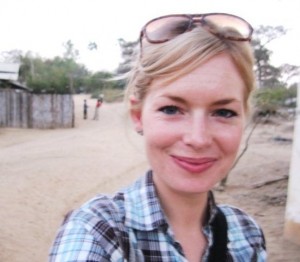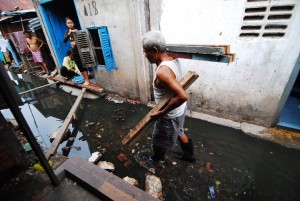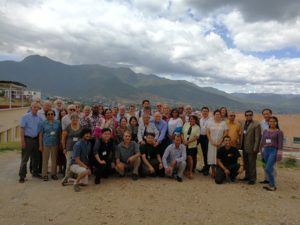How might decades of research about development-forced displacement and resettlement (DFDR) help inform responses to environment and climate change-related displacement?
Around 15 million people are displaced each year by large-scale infrastructure developments, such as dams, roads and bridges (IFRC 2012). Many of these people are formally resettled to new locations. While safeguards exist to protect people from the negative effects of displacement and resettlement, the research suggests that these processes continue to cause impoverishment for many communities (Scudder 2012). In most circumstances, it is generally agreed by researchers and practitioners in this field that resettlement should be an option of last resort (World Bank OP 4.12; Brookings Institution 2011).
When a decision is made to resettle a community, many variables affect resettlement outcomes, including the types of support provided, the way community consultation is conducted, the timing of relocation and the quality and location of resettlement sites. Valuable knowledge has developed about these variables in the context of resettlement for infrastructure projects. As environmental displacement increases, this knowledge is becoming more relevant to policy-makers in other fields.
This section focuses on how knowledge about resettlement might inform better policy responses for people displaced by natural disasters, climate change and other environmental processes. It provides resources which explain the impacts of resettlement on communities and highlight the relevance of resettlement research for policymakers responding to environmental displacement. It also highlights an emerging area of research about the impoverishment risks created by human efforts to adapt to environmental change, particularly climate change.
Environmental processes, such as natural disasters, flood, drought and slow onset-degradation are displacing increasing numbers of people each year (IFRC 2012). These types of ‘forced displacement’ take place on a continuum. Some people are directly displaced with little choice about when and how they move. Others are displaced indirectly, by secondary environmental and economic impacts, slowly making it untenable to continue living in their communities of origin. In some countries these processes are leading governments to resettle communities in the name of disaster-risk reduction, environmental conservation and climate change adaptation policies (De Sherbinin et al 2011).
There are a number of ways populations may be displaced and resettled as a result of environmental change or through policies aimed at mitigating and adapting to environmental change: [1]
- being directly displaced by environmental change (such as natural disasters) and then subsequently resettled to new locations;
- being at risk of environmental impacts (such as flood) leading governments to resettle populations in the name of adaptation or disaster-risk reduction;
- being displaced through the expropriation of land to enable climate change mitigation and adaptation measures, such as biofuel plantations, forest conservation and hydroelectric facilities;
- being indirectly displaced by losing access to valuable land and natural resources, such as forests incorporated into initiatives such as REDD (reducing emissions from deforestation and forest degradation).
We welcome contributions aimed at promoting an understanding of these types of displacements occurring in different parts of the world.
In particular, if you are aware of displacement and resettlement taking place in your region for climate change adaptation and mitigation, please email the section editors. Well-researched, empirical studies are preferred.
Editor Jessie Connell
Mekong Research Group, University of Sydney Contact FormSelected resources
Development-Forced Displacement and Resettlement (DFDR)
The field of DFDR has accumulated knowledge about the impoverishment risks of displacement and resettlement.
Scudder, T. (1993), ‘Development-induced Relocation and Refugee Studies: 37 Years of Change and Continuity among Zambia’s Gwembe Tonga’, Journal of Refugee Studies, 6:2, 123-152. http://jrs.oxfordjournals.org/content/6/2/123.full.pdf
Brookings Institution (2011), ‘A Historic Landmark in Development: Reflecting on the First Resettlement Policy – Interview with Michael Cernea’, Resettlement News 23/24,http://www.brookings.edu/research/articles/2011/07/copy-of-07-resettlement-cernea
Scudder, T. (2012), ‘Resettlement outcomes of large dams’. In: Tortajada, C., Altinbilek, D. and Biswas, A.K. (eds.) Impacts of Large Dams: A Global Assessment, pp.37-67, Springer: Berlin. [Book chapter]
IFRC (2012), *World Disasters Report – Focus on forced migration and displacement*, International Federation of Red Cross and Red Crescent Societies, http://www.ifrcmedia.org/assets/pages/wdr2012/
Displacement and resettlement associated with climate change adaptation and mitigation projects
Population resettlement in anticipation of climate change is already taking place in a number of countries, including Vietnam, China, Mozambique, the Carteret Islands and Bougainville in Papua New Guinea (De Sherbinin et al 2011; Hall et al 2011).
Communities at risk of displacement often live in informal settlements or in insecure or traditional land tenure regimes, without access to adequate legal protections. Resettlement poses particular social and cultural risks for minority groups.
De Sherbinin, A., Castro, M., and Gemenne, F. (2011), ‘Preparing for Population Displacement and Resettlement Associated with Large Climate Change Adaptation and Mitigation Projects’, Science, Vol. 334, 456-457,https://www.academia.edu/1185954/Preparing_for_resettlement_associated_with_climate_chan, and the Background Paper for the Bellagio Workshop 2-6 November 2010,http://www.ciesin.columbia.edu/confluence/download/attachments/92799210/Background_Paper_final.pdf
Hertel, T. W., Hussein, Z. (2013), ‘Climate Change Mitigation Policies and the Poor: Is Land Tenure the Missing Link?’ World Bank Land and Poverty Conference in 2013,http://geoshareproject.org/resources/86/download/Poverty_Impacts_of_Climate_Change_Mitigation-Short.pdf
Environmental displacement and migration
Environmental displacement and migration has been the focus of increasing research since the 1970s.
Susan F. Martin (2013), ‘Environmental change and migration: what we know’, Migration Policy Institute – Policy Brief, No.2, http://www.migrationpolicy.org/pubs/Migration-EnvironmentalChange.pdf
United Nations Institute Environment and Human Security, Where the Rainfalls Project,http://wheretherainfalls.org/
Foresight: Migration and Global Environmental Change (2011), Final Project Report, The Government Office for Science, London. http://www.bis.gov.uk/assets/foresight/docs/migration/11-1116-migration-and-global-environmental-change.pdf
[1]. These displacement scenarios are adapted from: De Sherbinin, A., Castro, M, and Gemenne, F. (2011), ‘Preparing for Population Displacement and Resettlement Associated with Large Climate Change Adaptation and Mitigation Projects’, Science, Vol. 334, 456-457.
Last Updated (Monday, 14 April 2014)





